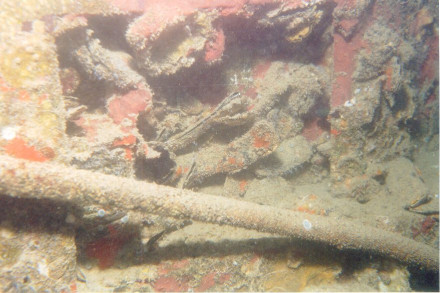History
Built between the world wars
The submarine Hr. Ms. O20 was completed in 1936 at the Fijenoord shipyard in Rotterdam for the Royal Netherlands Navy. It was commissioned under commander A.J. Bussemaker on 28 August 1939. On October 3rd the new submarine left for the Caribbean, together with the Hr. Ms. O15 and the artillery instruction vessel Hr. Ms. van Kinsbergen. The O20 then proceeded through the Panama Canal to the former Dutch East Indies and arrived there on December 23rd 1939.
World War II
On May 31st 1941 P.G.J. Snippe became the new commander. On 7 December 1941, Japan attacked Pearl Harbour and with this, WWII had also erupted in the Pacific. The Netherlands declared war on Japan on December 8th. The O20 was then stationed at the Singapore Submarine Base under command of the British Eastern Fleet.
Encounter with the enemy
On December 14th 1941, the O20 left the port of Singapore for patrol duty. The working area of the O20 was east of Kota Bharu, near the eastern coast of British Malaysia.
On December19th the O20 spotted two Japanese freighters that were sailing in convoy. They were accompanied by three destroyers, the Ayanami, Uranami and Yugiri. Ar0und 11:00 the periscope of the O20 was seen by Japanese aircraft that dropped two bombs on the submarine and notified the destroyers of its presence. Because of this, the submarine was lightly damaged at the starboard exhaust pipe.
Escape thwarted
They dove to the bottom with above them the Japanese destroyers that were dropping depth charges. A game of cat and mouse ensued. The O20 was able to avoid the bombs until dark. Then the bombing suddenly stopped. Around 21:00 the O20 emerged. The commander had the deck gun manned and went off as fast as they could. To be able to make more speed, commander Snippe ordered to empty fuel tank IV and because of this, the O20 was lying higher in the water. This would normally have been a good idea, but the damaged starboard exhaust was now above water and it produced a shower of sparks that could be seen from afar in the tropical waters.
Sinking
After this, they were detected by the Japanese and one of the destroyers closed in and opened fire. Following a short exchange of fire the submarine had been heavily damaged and the commander decided there was no hope for escape. The vessel was scuttled and the crew ended up in the water. Throughout the night, Uranami dropped depth charges in order to keep sharks away, and was able to rescue 32 survivors the following morning. Seven men, including the commander, were never found. The commander had entered the water without a life vest and it is possible that the six crew men were stuck in the engine room when the submarine went down.
Description
Yard: Dok en Werf Maatschappij Wilton-Fijenoord, Schiedam (the Netherlands)
Armament:
8 torpedo tubes
20 mine tubes
1x 8.8 cm cannon
1x 40 cm cannon
1x machine gun
She was laid down on June 15th, 1936 and launched on January 31st, 1939. The ship was commissioned on August 28th, 1939.

| Master | Snippe, p. G. J. |
|---|---|
| People on board | 39 |
| Power | 5300 hp |
| Speed | 19 knots ~ 22 mph (35 km/h) |
| Speed submerged | 9 knots ~ 10 mph (17 km/h) |
| Length | 264 ¾ feet (80.7 m) |
| Width | 24 ¼ feet (7.4 m) |
| Draft | 12 ¾ feet (3.9 m) |
| Displacement | 1145 ton |
| Displacement submerged | 1561 ton |
Status
Research in 2024
The Netherlands and Malaysia have conducted a joint maritime archaeological research on the locations of the wrecks of the Hr. Ms. KXVI and O20. This happened in close co-operation with the Ministries of Defense, Culture and Foreign Affairs of both countries and it was headed by the Cultural Heritage Agency of the Netherlands (RCE).

The O20 was found in the expected location, but it appears that the KXVII was illegally salvaged. On this location, no wreck was found, just dug up seabed and iron plating that was left behind, as well as objects connected to the salvage and the submarine. The iron of this type of ships is very valuable and sought after. It is of an unusual quality since it has been made before nuclear weapons were detonated in the atmosphere. Because of this, the steel has not been subjected to radioactivity during its production and it has a low background radiation - making it useful for specialist measuring equipment amongst other things.
Earlier, other submarines had been illegally salvaged in this area (Hr. Ms. KXVII and O16), so the worst was feared for the O20. The fact that the ship was still there was received with joy.
Earlier research
In June 2002, Dutch divers associated with the International Association for Handicapped Divers participated in a diving expedition to search for the wreck of the O20. Research done by Hans Besançon, son of the commanding officer of the KXVII, pointed them to a possible location, a wreck located approximately 35 NM North-East of Kota Bharu, Mayalsia, at a depth of 44 meters. The submarine appeared to be heavily damaged by shells. In order to identify the wreck the team has took photo and video material of the wreck and recovered a deck phone from the submarine. Analysis of the evidence by experts of the Royal Netherlands Navy definitively identified the wreck as the O20.


Even though the wreck of the O20 is a designated war grave, World War II wrecks such as this one are under constant threat of being commercially salvaged.
